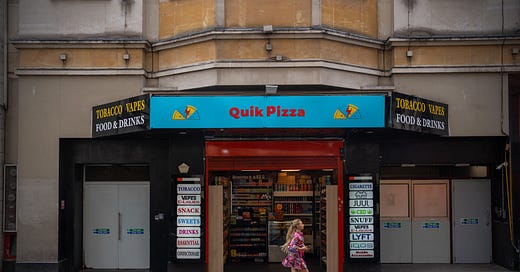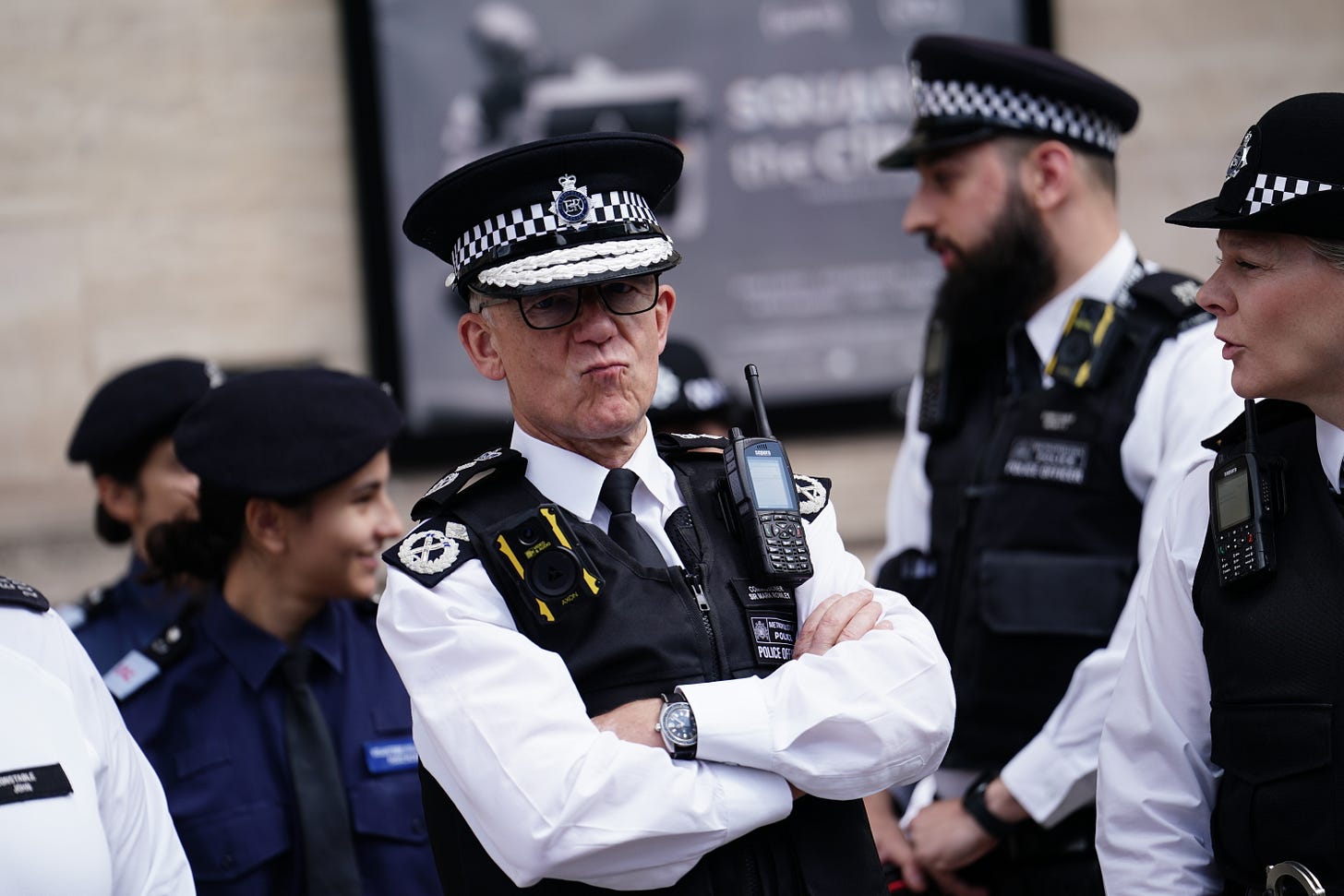Last week was a big week for anyone interested in reading chunky PDFs that purport to foretell the future of London. So in today’s issue we’re digging into what we’ve learned about the fate of ‘the nation's favourite high street’ and the attempted redemption of the Met.
Before we get into it, just a reminder that our Monday editions are completely free to read, but if you enjoy London in Bits then you might want to sign up to become a LiB supporter for £5 a month or £50 a year. The only reason we don’t have to run adverts or take money from sponsors is because hundreds of people choose to support what we’re doing.
If you become a subscriber then you’ll start getting our Wednesday issues (this week we have an interview with the artist who uses laser beams to capture London properties owned by offshore companies), as well as access to the entire back catalogue of paywalled articles, including our growing ‘Before You Go’ series, in which we visit some of London’s most beloved but endangered spots; and our ‘Electric Theatre’ series, where a different contributor writes about one of their favourite examples of London on film every month.
The Oxford Street shuffle
The last time we wrote about Oxford Street was back in March, and things were not looking great. Westminster Council had just scrapped its doomed £150 million ‘pedestrian piazza’ project; the number of candy shops had returned to peak levels despite the council’s best attempts to rid the area of overpriced gobstoppers and dodgy vapes; and, of the 269 retail units on the street, 42 were lying empty:
The “more detailed plan for the Oxford Street project” was due later that month, but it didn’t actually materialise until last week when Westminster Council published their “long-term vision for the nation’s favourite High Street”.
Proposed changes include improving the overall appearance and usability of the street, increasing space and safety for people on foot, enhanced lighting, and the addition of more green areas with seating. There’s also a proposal to add “12 new controlled pedestrian crossings” and 16 “designated amenity spaces” (they really know how to name something at Westminster Council don’t they?).
One of the biggest changes will be the extension of the traffic restrictions, making more stretches of Oxford Street “bus, taxi and cycle only areas” from 7am to 7pm seven days a week.
If you want to have your say on the plans you can find the full thing here and you’ve got until midnight on 31st August to respond to the questionnaire.
Fewer sweets, more start-ups
A couple of days after that consultation, the council followed it up with the launch of the overly-coloned Meanwhile On: Oxford Street scheme, which offers “innovative, cutting-edge and up-and-coming brands” the chance to “take over a shop on Oxford Street, rent-free” for a six-month period.
There are nine empty stores up for grabs to begin with, all of which were previously occupied by the ‘candy stores’ or other businesses that the council perceives as “low quality occupiers”. Although the ‘Candy World’ at 363 Oxford Street has already been snapped up by HMV, which used to have its flagship store at the site.
The first small firms are expected to set up shop in August.
We don’t get knocked down
The third and final bit of Oxford Street news from last week came in the form of a 127-page report from the Department of Housing & Communities; the TL;DR version of which is ‘Michael Gove says Marks & Spencer can’t demolish its Oxford Street store’.
M&S had wanted to flatten their 1930s flagship store and replace it with a building designed by architects Pilbrow & Partners, which, it was claimed, would “lead to lower lifetime carbon emissions than could be achieved with a retrofit”.
But the Secretary of State for Housing and Communities decided that the almost 40,000 tonnes of embodied carbon that would be generated by the demolition was just too much. Gove also said that “the height and appearance of the cornice of the proposed development would be prominent and distracting from the Selfridge’s facade” (the M&S building is directly opposite Selfridges).
The campaign group SAVE British Heritage put out a statement following the decision, calling it “a hugely important decision that rightly challenges the way we continually and needlessly knock down and rebuild important buildings across our towns and cities. Repurposing and converting buildings we cherish and saving thousands of tonnes of C02 in the process is a no brainer. This is a massive positive step and we salute the Secretary of State.”
Don’t worry though, another proposal has arrived for everyone to start arguing about. A couple of weeks ago, the London Heritage Quarter business group, released their blueprint to make Parliament square “more accessible and pedestrian-friendly”.
Mark my words
Another hefty and long-awaited report was published last week. A New Met for London is the force’s (and, more specifically, Commissioner Mark Rowley’s) response to the Baroness Casey report, which accused the the Met of being “institutionally racist, sexist and homophobic”. The report lays out a two-year, £366 million plan that it hopes will “increase trust in the force, reduce crime and raise policing standards”.
Rowley hopes to achieve this ‘mission’ by “working with the public to build a new, communities first approach;” becoming an “anti-discrimination organisation” that is able to “uphold the highest standards and remove those who don’t meet them;” and fixing recruitment and improving leadership to create “a well-run organisation” (we are summarising ruthlessly here; for more detail the Met has a summary of the report’s aims on this page).
One of the biggest stories to come out of the new plan was the introduction of the Cambridge Crime Harm Index to target “the most prolific perpetrators of violence against women and girls”. The Cambridge Crime Harm Index is a system that measures the seriousness of crimes (rather than just the number of them) and it’s previously only been used on terrorism and organised crime. But the Met says it will be applying it to assess the 35,000 offenders reported each year for crimes against women and girls “in a bid to rank the 100 who are most dangerous to the public”.
On the subject of ‘removing people’ from the Met, Rowley went on the Today programme last week, to complain that he still hasn’t heard the results of the Home Office review that would help him to sack officers more easily. “I need those changes in regulations,” Rowley said, “because some of the processes are too long and too bureaucratic.”
We wish we could say that the plan came out in a week absent of Met bad news stories, but those don’t really exist anymore. As well as the revelation that data on people using the Met’s website “to report sexual offences, domestic abuse and other crimes” had been passed to Facebook; there was also the publication of a “damning report” criticising officers’ use of schedule 7 of the Terrorism Act to confiscate a French publisher’s phone and laptop at St Pancras station in April; and the announcement of four separate IOPC investigations into the Met's handling of reports about David Carrick.
And, of course, last week also saw the Met publicly apologise for its “corrupt and incompetent” inquiry into the Daniel Morgan murder, which was followed by the payment of an unprecedented £2 million settlement to Morgan’s family.
Following the Met’s apology, the Morgan family’ solicitor was quoted as saying:
“The challenge for [Rowley] is to find the courage and integrity to put those words of his apology into action. It is for him to find the courage and the integrity necessary to face up to the sickness in the Met with which this family has had to live over the decades: a sickness where a perceived need to protect the organisation from reputational damage has served only to nurture and encourage a culture of impunity in his organisation.”
5 Little Bits
In the early hours of Friday morning a derelict mansion located on ‘Billionaire’s Row’ (aka The Bishops Avenue on the north side of Hampstead Heath) was gutted in a huge fire. The house, which is locally referred to as The Towers, has been abandoned for years and the only people to occupy it recently have been ‘urban explorers’.
Over in The Guardian, columnist Simon Jenkins has written a gleeful obituary for Canary Wharf, which is also a plea for London to end its “slavish devotion” to “random high-rise office developments” and instead create the kind of “stylish, informal, human-scale spaces, as is offered in London by the West End and fringe neighbourhoods.”
Meanwhile, over in The Telegraph, Emma Beaumont has joined the chorus of people bemoaning the demise of London’s nightlife, who complain that “finding somewhere decent to eat and drink after a concert has become a quest of epic proportions” and “Westminster Council, would rather have Harry Potter merch shops and American candy stores than bars or clubs”.
The finalists for the Great British Pub awards have been announced, and in the ‘Best City/Urban Pub’ category you’ll find Bexleyheath’s The Kings’ Arms, The Audley in Mayfair, The George IV in Chiswick, and Twickenham’s The Turk’s Head. The Kings’ Arms is also up for ‘Best Pub for Entertainment’ along with The Phoenix Arts Club.
Twitter isn’t good for much these days, but thankfully you can still watch the adventures of cyclist Travis and his cat Sigrid, specifically what happens when Sigrid catches site of a fox.
Bonus links (because they’re paywalled): The FT has interviewed Michael Chambers, the 81-year-old owner of the beautiful Garden Cinema in Covent Garden; and Caity Weaver has been on a very entertaining search for Tom Cruise’s semi-mythical Biggin Hill home for The New York Times.







